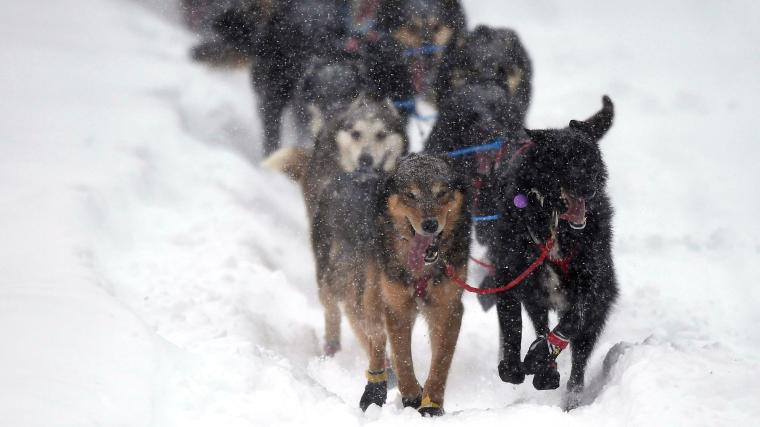The Return of a Timeless Tradition
After a rich history spanning more than five decades, the 53rd annual Iditarod Trail Sled Dog Race is set to return, bringing a wave of excitement and nostalgia to the vast, snowy landscapes of Alaska. This iconic race, which celebrates the endurance and spirit of both humans and huskies, has become a beloved event, drawing participants and spectators from around the world. This year, 33 mushers are gearing up to compete, each with a team of dogs ready to tackle the grueling 1,128-mile journey from Fairbanks to Nome. However, the absence of a notable champion, Dallas Seavey, adds a layer of unpredictability to the field. Dallas, who has won the race a record six times, will not be participating this year, leaving the spotlight for other seasoned racers and promising newcomers. Among these is Dallas’ father, Mitch Seavey, who is returning with the goal of capturing his fourth title, a feat he last achieved in 2017.
The Race Schedule: Key Dates and Times
The Iditarod Trail Sled Dog Race is a well-orchestrated event with two distinct starts: the ceremonial start and the official restart. The ceremonial start, a festive send-off that captures the spirit and camaraderie of the race, will kick off at 10 a.m. local time on Saturday, March 1, 2025. For those watching from the East Coast, the event will be broadcast at 2 p.m. ET. The official restart, which marks the beginning of the competitive portion of the race, is scheduled for 11 a.m. local time on Monday, March 3, and will be available to viewers at 3 p.m. ET. These starts are crucial, as they set the tone for the upcoming days of intense competition andmts 1,128 miles of challenging terrain, from the dense forests of the Alaskan interior to the icy shores of the Bering Sea.
The Route and Challenges of the 2025 Iditarod
The 2025 Iditarod Trail Sled Dog Race will follow the traditional route from Fairbanks to Nome, Alaska, covering a total distance of 1,128 miles. This route is a testament to the resilience and determination required to complete the race, as mushers and their teams face a myriad of challenges, including harsh weather conditions, treacherous trails, and the need to navigate through remote and often unforgiving landscapes. The race is divided into several checkpoints, each serving as a critical stop for rest and resupply. While recent winners have completed the race in just under nine days, mushers at the back of the pack may need nearly two weeks to reach the finish line. The race not only tests their physical and mental limits but also their ability to manage and care for their canine companions, ensuring their welfare throughout the journey.
How to Watch the 2025 Iditarod
For those unable to witness the Iditarod in person, the race offers extensive coverage through various media platforms. The official Iditarod website provides a live stream of the event, allowing spectators around the globe to follow the race in real-time. This live stream captures key moments, checkpoints, and the overall progress of the mushers and their teams. Additionally, the website offers detailed updates, interviews, and behind-the-scenes content that enhances the viewing experience. Whether you are a die-hard fan or a casual observer, these resources provide a comprehensive look at one of the world’s most challenging endurance races.
The 2025 Mushers and Their Teams
This year’s Iditarod field boasts a mix of seasoned veterans and fresh faces, each bringing their unique experiences and strategies to the race. Among the 33 mushers, notable names include Ryan Redington and Mitch Seavey, both of whom have tasted victory in previous editions of the race. Ryan Redington, the 2023 winner, will be looking to defend his title, while Mitch Seavey, a three-time champion, aims to secure his fourth victory. The race also welcomes first-time participants, adding a new dimension of excitement and competition. Each musher must start with a minimum of 12 dogs and can have up to 16 on their team. The bond between musher and dog is a cornerstone of the race, and the success of each team depends on the strength and cooperation of this relationship.
A Legacy of Champions: The Iditarod’s History
The Iditarod Trail Sled Dog Race has a storied history, with a list of legendary winners who have etched their names in the annals of the event. Dallas Seavey holds the record for the most victories, with six wins, closely followed by Rick Swenson with five. These champions have not only demonstrated exceptional racing skills but have also become symbols of the race’s spirit and dedication. The race has seen a diverse array of winners over the years, from first-time victors like Libby Riddles in 1985 to repeat champions like Susan Butcher, who won four times consecutively from 1986 to 1990. Each victory is a testament to the hard work, perseverance, and teamwork that define the Iditarod. As the 2025 race approaches, the legacy of these champions serves as inspiration for the current field, pushing them to achieve greatness in one of the world’s most challenging sporting events.
The Spirit of the Iditarod
The Iditarod Trail Sled Dog Race is more than just a competition; it is a celebration of the deep bond between humans and dogs and a tribute to the pioneering spirit of Alaska. The race retraces the historic 1925 serum run, where mushers and their teams delivered life-saving medicine to the remote town of Nome, overcoming incredible obstacles along the way. This historical context adds a sense of purpose and honor to the event, making it not just a test of physical endurance but also a journey of historical significance. As the 2025 Iditarod gets underway, it is a reminder of the enduring traditions and the human and canine partnerships that have shaped Alaska’s rich cultural heritage. The race continues to captivate audiences with its blend of adventure, tradition, and the awe-inspiring beauty of the Alaskan wilderness.











